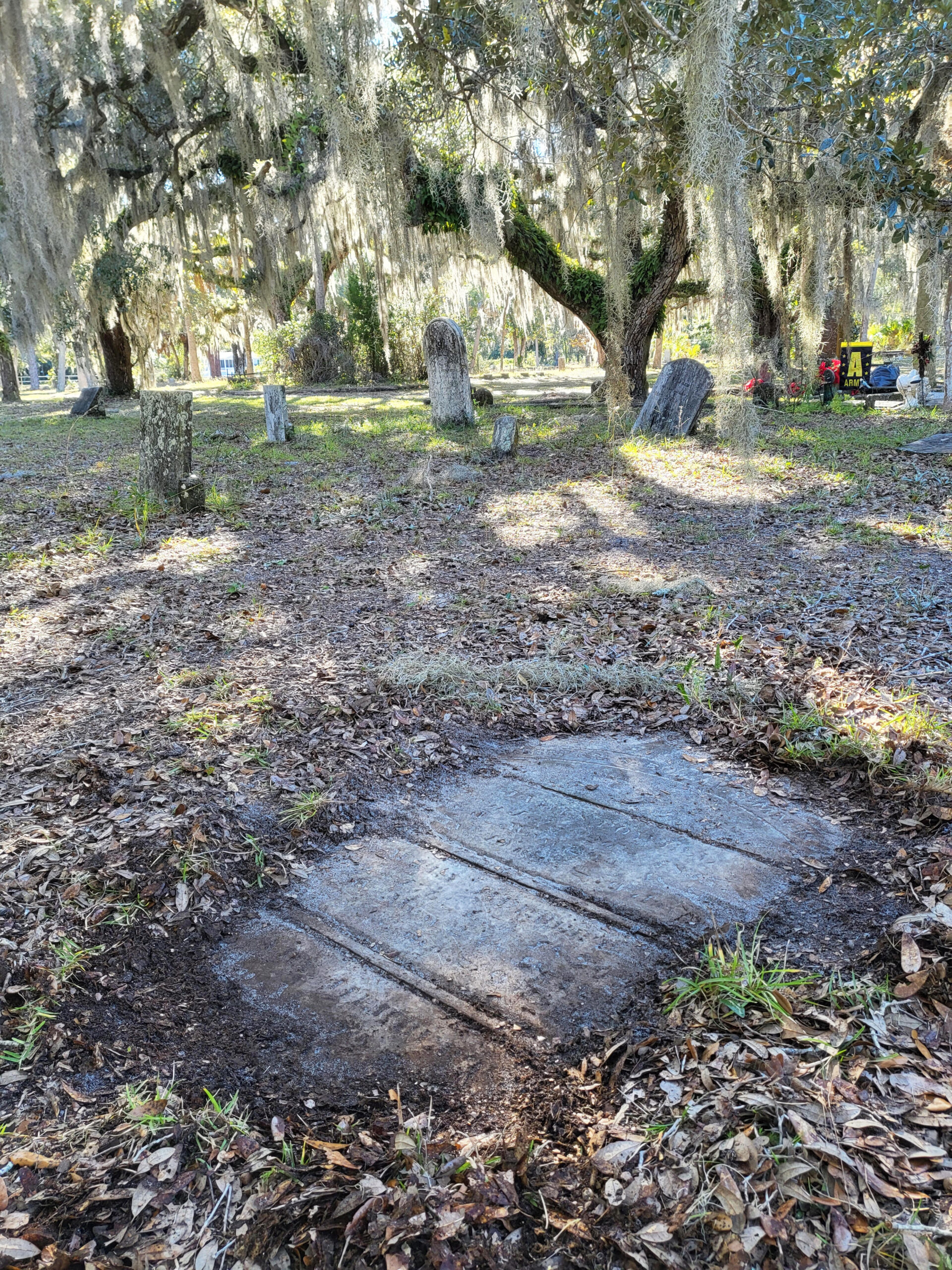Chasing Shadows: The ‘mostly forgotten’ story of the Semmeses
By Pam Richardson Guest Columnist
On a recent bright, but chilly afternoon I had the pleasure of riding around Apalachicola with local realtor Shaun Donahoe. The purpose of our jaunt was to look at real estate, but not with an eye to my purchasing any of it.
instead, I was picking Donahoe’s brain about people and stories associated with many of the city’s old houses. Donahoe, who has lived in Apalachicola for 50 years, has a backlog of historical facts – and no doubt some fiction – that he is happy to share.
Suddenly remembering something he wanted to show me, Donahoe swung his car onto Bluff Road and drove us out to Magnolia Cemetery. We parked in the old section of the graveyard, and I followed him over to a piece of bare ground where he started pushing dirt, leaves, and strands of Spanish moss aside with his foot. It was soon evident that an inch or two under the debris was a large stone slab lying flat on the ground. We both got on our knees, clawing and wiping at the dirt, until we’d exposed all the words on the old stone. They read:
In Memory of the Children of Albert G. and Isabella V. Semmes
James Powell, born July 20, 1835, died May 29, 1841, aged 5 yr, 10 mo, 9 days
Mary Herbert, born Feb 13, 1839, died May 8, 1841, aged 2 yr, 3 mo, 24 days
Mary Herbert, born Nov 9, 1842, died Jan 19, 1843, aged 2 mo, 10 days
We sat back trying to take in the enormity of the Semmes family’s loss; all three of their little children gone in less than three years! We were also confused by their 1840s death dates, as we knew that the cemetery hadn’t opened until the end of that century. The Semmes name was familiar to me, but I couldn’t remember a single thing about its members, so it wasn’t till I got home to my computer and hard-copy files that I was able to come up with some biographical information.

Buried in a bulging manilla folder labeled “Miscellaneous Apalach History,” I found a copy I’d made of a short paper written by Margaret Key entitled History and Mystery of Apalachicola. Key (1901-1996) was one of our best local historians and, in this essay, she described Albert Semmes as “a man who has been mostly forgotten and ignored in the town’s history.”
Today, more than 50 years after Key wrote her essay, Semmes is, if anything, even less well known. In the interest of not losing him forever, here then is Semmes’ story.
Albert Gallatin Semmes was born in August 1810 in Augusta, Georgia. His third great-grandfather, Marmaduke Semmes (1635-1692) had come to Maryland from Nantes, France about 1662, married Fortuna Watson, a wealthy widow, in 1668 and eventually owned almost 1,000 acres of land. The Semmes became a notable family in Maryland and remained there until Abert’s father moved to Georgia.
Albert graduated from the University of Georgia, gained admission to the state bar by reading law, and, in 1834, married his first cousin, Isabella Valentine Semmes who is said to have been born in Cuba.
In 1835, on 100 acres in Washington, Georgia, he built a 2-over-2 saltbox style house which is today the home of the Washington Historical Museum. Then, in 1837, Albert and Isabella left Washington with their son, James, and moved to Apalachicola. Issues of the Apalachicola Gazette from that period contain numerous notices of legal suits, and Albert Semmes – sometimes with, sometimes without his partner, William George Mackey Davis – is often listed as the “plaintiff’s attorney.” Their place of business was at #35 Water Street. (Davis went on to become a brigadier general for the Confederacy in the Civil War and as well as a colleague of Albert Semmes’ half-brother, Paul Jones Semmes, also a brigadier general, who was mortally wounded at the Battle of Gettysburg. Albert was also related to Admiral Raphael Semmes of the Confederate Navy.)

In addition to his law practice, Semmes was involved with local politics and was known as a pro-statehood, pro-banking, religiously conservative Middle Florida Whig. When the call was put out for a constitutional convention to be held at St. Joseph in 1838, Apalachicola named both Albert Semmes and Cosam Emir Bartlett, editor of the Apalachicola Gazette, to be its delegates. Bartlett, according to Key, described Semmes as “a man of high moral purpose who had the fear of God before his eyes.”
Records show that Semmes owned nine slaves in 1840 and that he shipped two slaves from Apalachicola to New Orleans, one in 1844 and one in 1847. In both 1850 and 1860, Semmes’ household included two enslaved people.
In 1840, Semmes ran for mayor of Apalachicola, but he was defeated by Boston-born, and bred, Marshall P. Ellis, a prominent merchant. Losing the election, however, was just the beginning of Semmes’ bad luck. In 1841, he and Isabella lost both of their children, James and Mary, two weeks apart in the month of May. The yellow fever epidemic which hit both St. Joseph and Apalachicola at that time was probably to blame.
A year and a half later, Isabella bore another child, a girl, whom she named after the one who had died in 1841. But “poor grieving Mrs. Semmes,” as Margaret Key wrote, “then lost her, too.” Isabella was not quite 30 years old, and she and Albert must have suffered with only the memory of their children in the family’s large, two-story, double-galleried house facing the bay where today 11th Street meets Bay Avenue.
However, it wasn’t until 1848 that Isabella bore her fourth and last child, another girl, whom she named Frances Isabel. Fanny, as she was known, thrived, and the Semmes home came alive again.
But not for long.
In 1851, the State Legislature appointed Semmes to the Florida Supreme Court, as its eighth justice. But, when he stood for popular election two years later, he lost. He was by this time 45 years old and, perhaps suffering from so much personal and professional loss, he packed up his family and moved to New Orleans to be close to his brother.
There, Semmes practiced law, but did not otherwise make any kind of a name for himself. Isabella died in 1872 (age 58), her only living child, Frances Semmes Sherwood, died in 1879 (age 31) and Albert died in 1883 (age 73).
As for the old Semmes house on the bay, the only one on the whole block, Margaret Key says that at the time of the Civil War it was owned by a Dr. Hunter (John Mercer Garrett Hunter, born 1805 in Virginia, died 1876 in Apalachicola), but lived in by Miss Maggie Buzzett’s grandmother, Margaret Norton, a caretaker “right from Belfast, Ireland,” while Dr. Hunter served as a surgeon in the Confederate Army.
The house was later destroyed, probably by fire, and its replacement is the current
house which was lived in, from the mid-1900s on, by the Creekmore family. “For many years,” Key wrote, “a flat gravestone lay in the alley north of the Creekmore home. And quite some time ago, possibly in the 1930s, it was removed to Magnolia Cemetery.”
She speculated that the three Semmes children had been laid to rest in the family’s garden. We don’t know whether the children’s remains were moved with their gravestone to the cemetery or whether they still lie beneath the alley in Block 46, but what is obvious is that with each passing year the stone dedicated to their memory is sinking deeper into the earth, threatening to obliterate the last trace of the Semmes name from the history of Apalachicola.
Author’s note: The discovery of Margaret Key’s information about Semmes was meaningful to both Donahoe and Richardson because she was Donahoe’s neighbor and friend and Richardson’s distant relative (Stephen Coffin, 1652-1734, of Nantucket was Key’s sixth great-grandfather and Richardson’s ninth great-grandfather.)
Pam Richardson is president of the Apalachicola Area Historical Society. She can be reached at stoneoak2003@yahoo.com.





Meet the Editor
David Adlerstein, The Apalachicola Times’ digital editor, started with the news outlet in January 2002 as a reporter.
Prior to then, David Adlerstein began as a newspaperman with a small Boston weekly, after graduating magna cum laude from Brandeis University in Waltham, Massachusetts. He later edited the weekly Bellville Times, and as business reporter for the daily Marion Star, both not far from his hometown of Columbus, Ohio.
In 1995, he moved to South Florida, and worked as a business reporter and editor of Medical Business newspaper. In Jan. 2002, he began with the Apalachicola Times, first as reporter and later as editor, and in Oct. 2020, also began editing the Port St. Joe Star.